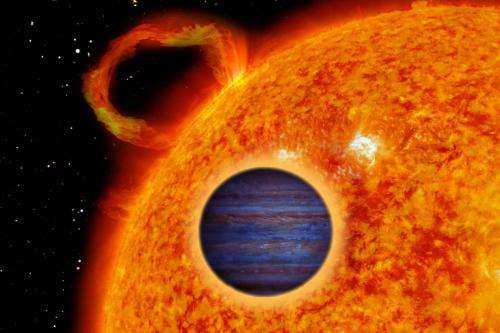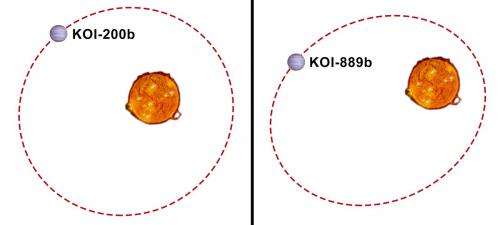Detection of two new exoplanets with Kepler, SOPHIE and HARPS-N

An international team of astronomers, including Alexandre Santerne of the EXOEarths team at CAUP, identified and characterized two new exoplanets, thanks to combined observations from the Kepler space telescope, plus SOPHIE and HARPS-N spectrographs.
These planets, named KOI-200 b and KOI-889 b are among the first detected with the new high-accuracy spectrograph HARPS-N, the northern hemisphere counterpart of the most prolific exoplanet hunter, HARPS (ESO). CAUP researcher Alexandre Santerne commented: "The SOPHIE spectrograph was already playing an important role in the characterization of Kepler planets by unveiling the true nature of the candidates and measuring the mass of giant planets. With the new HARPS-N spectrograph, with an even better accuracy, we expect to characterize much smaller exoplanets, hopefully down to the size of the Earth."
The new planets have about the size of Jupiter, but eccentric orbits with periods of less than 10 days. These new results help to further understand the evolution of orbits of these planets located very close to their star, known as "hot Jupiters".
There are currently more than 850 known exoplanets, but as seen from the Earth, only some of them are oriented in a way that they are passing in front of their star every orbital period. These periodic transits of the planet in front of its star produce a small dip in its brightness. These micro eclipses allow astronomers to know the diameter of the planet and some details about its atmosphere.

The Kepler space mission (NASA) has identified more than 2000 stars that have great chance of hosting transiting planets. However, most of them need complementary ground-based observations to establish their nature and to complete their characterization.
The team participated to these ground-based observations since 2010, using the SOPHIE instrument, which has already participated in the detection and characterization to more than fifteen Kepler planets, through the radial velocity method. Their observing program is now completed by new observations with the more accurate HARPS-N spectrograph.
KOI-200 b is slightly bigger than Jupiter and slightly less massive. With a low density, this gaseous planet is orbiting around its star in less than one week. The planet KOI-889 b is of the size of Jupiter but is ten times more massive. This very-massive planet is orbiting around its star in slightly less than 9 days. These two planets have eccentric orbits: during their orbit, their distance to their star is varying. This produces large variation in their equilibrium temperature of several hundred of degrees in a few days.
KOI-889 b, which is among the most massive planets discovered so far, is also among the most eccentric transiting planets. It could have been formed by a different mechanism than less massive planets. Santerne added: "Even if there are just hot and giant planets as we already know hundreds of them, these two planets are orbiting on a highly eccentric orbit, which is relatively rare for such short-period planets. I prefer to see these two new planets as two other bricks in the wall of our knowledge about planetary systems: bigger is the wall, better we understand planetary formation and evolution."
Provided by Centro de Astrofísica da Universidade do Porto




















